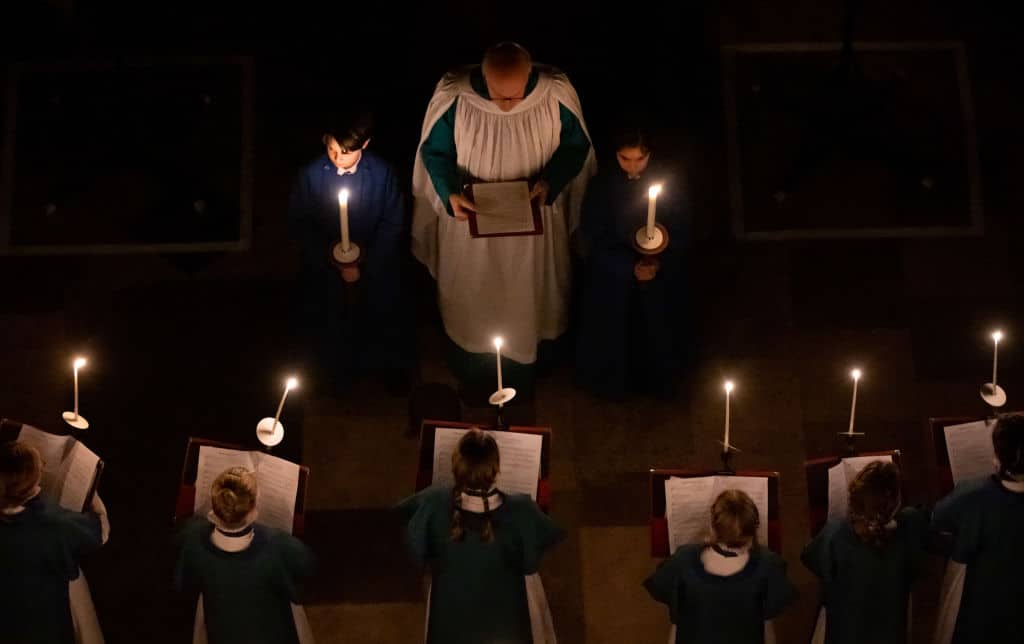Family traditions get made, repeated and remembered at Christmastime. From setting Christmas puddings ablaze with brandy to finding stockings at the end of the bed first thing on Christmas Day morning, families celebrate the season with festive traditions new and old.
As the mother of a one-year-old son, I’ve been reflecting on these traditions more this year than before. In the hope of integrating more traditions into our family life that are both festive and Catholic, the concept of “liturgical living” has provided me with food for thought.
Many Catholics will already live liturgically. Indeed, practising Catholics cannot avoid living a life directed by the Church’s calendar. Mass attendance on Sundays and Holy Days of Obligation, coupled with broader celebrations for Christmas and Easter, along with abstinence from meat on Fridays, offer the most obvious examples of ways in which the liturgical calendar holds sway over our lives.
The liturgical living concept, however, as popularised by some Catholic authors and social media accounts, would challenge Catholics to adopt a more pervasive approach, bringing something of the liturgy found at church actually into one’s home.
Liturgical living would take certain customs and carry them out with clear intentionality. Rather than just attend Mass on Sunday, one might make Sunday a mini-celebration by indulging in dessert specifically or only on that day, or by refraining from unnecessary work.
Similarly, one might try to mark particular feast days by commemorating the day’s saint with a themed meal, act or craft – a pint of Guinness on St Patrick’s day, perhaps. These tokens of commemoration should not supplant Mass attendance, but offer extra opportunities in the day to ponder the liturgical year. The practices should complement one’s prayer life and are often done with the aim of passing the faith on to one’s children or younger relatives.
For anyone wishing to live more liturgically, December offers the prime opportunity to start. Amid the advent calendars, carolling and Christmas lunch feasting, there are plenty of low hanging baubles when it comes to ideas for embracing liturgical living.
As Gavin Ashenden <a href="https://catholicherald.co.uk/christians-are-called-to-a-vocation-of-both-feasting-and-fasting-according-to-their-strengths-and-weaknesses/"><mark style="background-color:rgba(0, 0, 0, 0)" class="has-inline-color has-vivid-cyan-blue-color">articulated</mark></a> for the <em>Herald</em> earlier in December, the Church has, in her wisdom, invited us to participate in a rhythm of fasting and feasting during Advent and Christmas. The prevalence of chocolate advent calendars might not sit well with Advent’s penitential tone, but there are other ways to mark the liturgical year if we fall short in our gastronomical renunciations.
There are myriad ways in which one could start living the liturgical year more fully this Advent and Christmas. Many saints have their feast days in December. Although it’s too late to mark St Nicholas’s feast day with the tradition of leaving shoes out and filling them with something lovely for the next morning, we have the feast of St Lucy on the 13th and St Stephen’s Day on the 26th during December.
Scandinavian countries mark St Lucy’s day with candlelit processions and saffron buns, the recipe for which can easily be found online. Families could wear red to Mass on St Stephen’s Day as a reminder of his martyrdom. And, on the theme of colour-coding our attire, why not wear pink (or, <em>rose</em>, to be precise) this Gaudete Sunday, the Third Sunday of Advent?
If we find ourselves overindulging during Advent (perhaps on too many of those tasty saffron buns), we could observe the traditional calendar Ember Days – days set aside for prayer and fasting – during the week before Christmas.
When Christmas finally arrives, why not celebrate for the full twelve days? The secular world inverts Advent and Christmas by feasting and partying up until Christmas, and soberising and dieting come the New Year.
A dismaying <a href="https://d3nkl3psvxxpe9.cloudfront.net/documents/YG-Archive-ChristmasInternal-121218.pdf"><mark style="background-color:rgba(0, 0, 0, 0)" class="has-inline-color has-vivid-cyan-blue-color">70 per cent</mark></a> of adults think shops should take down Christmas decorations within a week of Christmas Day. And yet December 25 is the start, not the end, of Christmas. A small act of rebellion against a short-lived Christmas would be to leave decorations up until Epiphany, as was still the widespread practice until more recently.
Scrooges may dismiss such ideas as excessively kitsch or cliché, and admittedly some liturgical-living ideas are a tad twee. But colour-coding with Gaudete Sunday strikes me as far less gauche than Christmas jumper day, while leaving the tree up until Epiphany seems less excessive than shops stocking Christmas cards in early autumn.
All that said, readers shouldn’t let the idea of liturgical living overwhelm them. The market forces behind the secularisation or Christmas heap undue stress on too many at this time of year. A Christmas lived liturgically isn't about keeping up with the Catholic instagrammers; it’s a concerted effort to live the joy of the season more fully.
For our family, adding an extra layer of liturgy into our homes has meant opting for an Advent calendar with a Gospel passage behind each window and burning an advent candle after the evening meal (admittedly forgetting some evenings; there is a lot going on, as there is for everyone as the year rushes on to a close).
Then we’ll decorate the house during the week of Christmas. We may use the excuse of looking after a toddler to justify leaving decorations up until Candlemas. Liturgical living doesn’t stop at Epiphany, after all.
<a href="https://catholicherald.co.uk/christians-are-called-to-a-vocation-of-both-feasting-and-fasting-according-to-their-strengths-and-weaknesses/"><mark style="background-color:rgba(0, 0, 0, 0)" class="has-inline-color has-vivid-cyan-blue-color"><strong><em>RELATED: The Christian Faith is one of paradox: Why Christmas and Advent unite the mysteries of fasting and feasting</em></strong></mark></a>
<em>Photo: Candles are lit on the head dress of Sara Ringkrans, a primary school teacher in York, who moved to the UK from Stockholm, Sweden, as she prepares to lead the Sankta Lucia festival of light service at York Minster on 19 December 2013, York, England. The Swedish tradition of Sankta Lucia symbolises bringing light into the dark winter and is one of the most significant services in the Swedish ecclesiastical calendar. (Photo by Ian Forsyth/Getty Images.)</em>



